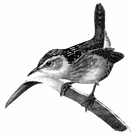Cistothorus platensis
Also found in: Thesaurus, Wikipedia.
Related to Cistothorus platensis: sedge wren
ThesaurusAntonymsRelated WordsSynonymsLegend:
Switch to new thesaurus
| Noun | 1. |  Cistothorus platensis - small American wren inhabiting wet sedgy meadows Cistothorus platensis - small American wren inhabiting wet sedgy meadowsmarsh wren - a wren of the genus Cistothorus that frequents marshes |
Based on WordNet 3.0, Farlex clipart collection. © 2003-2012 Princeton University, Farlex Inc.